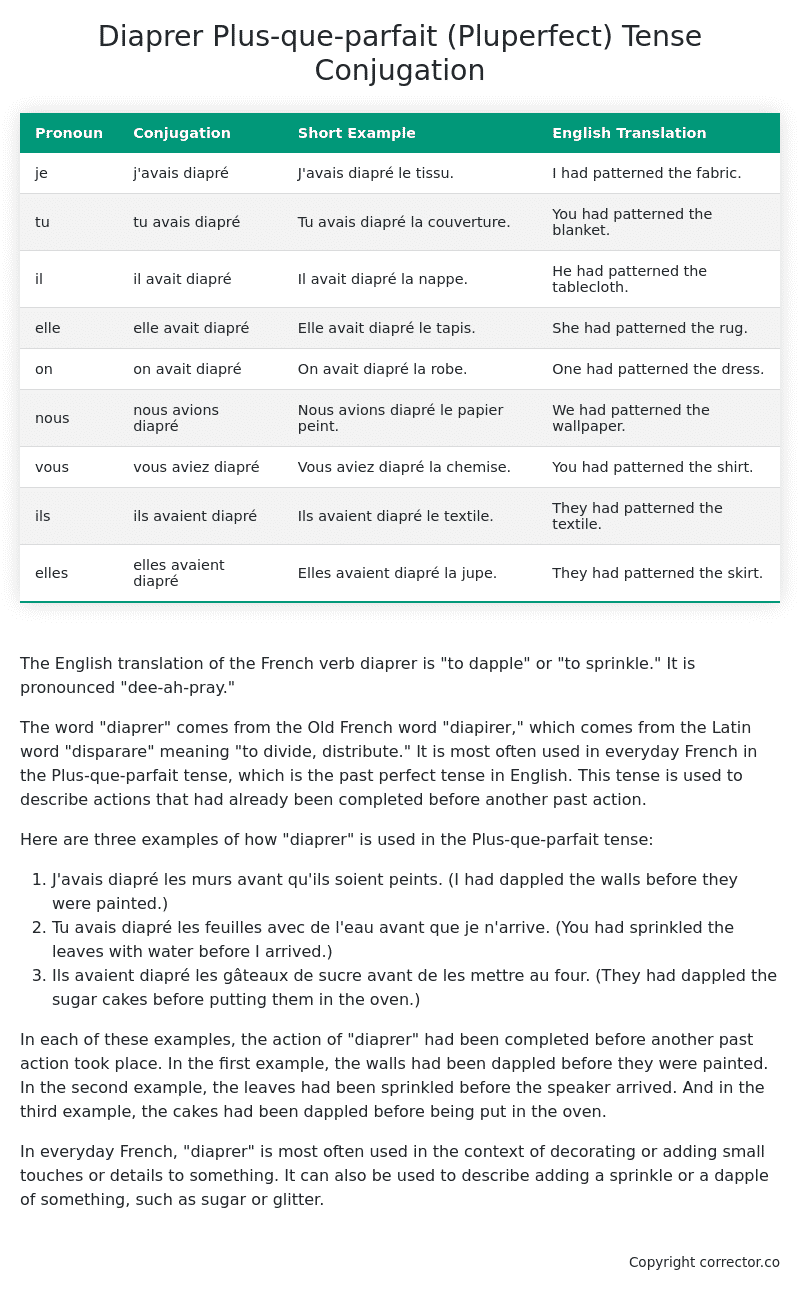Plus-que-parfait (Pluperfect) Tense Conjugation of the French Verb diaprer
Introduction to the verb diaprer
The English translation of the French verb diaprer is “to dapple” or “to sprinkle.” It is pronounced “dee-ah-pray.”
The word “diaprer” comes from the Old French word “diapirer,” which comes from the Latin word “disparare” meaning “to divide, distribute.” It is most often used in everyday French in the Plus-que-parfait tense, which is the past perfect tense in English. This tense is used to describe actions that had already been completed before another past action.
Here are three examples of how “diaprer” is used in the Plus-que-parfait tense:
- J’avais diapré les murs avant qu’ils soient peints. (I had dappled the walls before they were painted.)
- Tu avais diapré les feuilles avec de l’eau avant que je n’arrive. (You had sprinkled the leaves with water before I arrived.)
- Ils avaient diapré les gâteaux de sucre avant de les mettre au four. (They had dappled the sugar cakes before putting them in the oven.)
In each of these examples, the action of “diaprer” had been completed before another past action took place. In the first example, the walls had been dappled before they were painted. In the second example, the leaves had been sprinkled before the speaker arrived. And in the third example, the cakes had been dappled before being put in the oven.
In everyday French, “diaprer” is most often used in the context of decorating or adding small touches or details to something. It can also be used to describe adding a sprinkle or a dapple of something, such as sugar or glitter.
Table of the Plus-que-parfait (Pluperfect) Tense Conjugation of diaprer
| Pronoun | Conjugation | Short Example | English Translation |
|---|---|---|---|
| je | j’avais diapré | J’avais diapré le tissu. | I had patterned the fabric. |
| tu | tu avais diapré | Tu avais diapré la couverture. | You had patterned the blanket. |
| il | il avait diapré | Il avait diapré la nappe. | He had patterned the tablecloth. |
| elle | elle avait diapré | Elle avait diapré le tapis. | She had patterned the rug. |
| on | on avait diapré | On avait diapré la robe. | One had patterned the dress. |
| nous | nous avions diapré | Nous avions diapré le papier peint. | We had patterned the wallpaper. |
| vous | vous aviez diapré | Vous aviez diapré la chemise. | You had patterned the shirt. |
| ils | ils avaient diapré | Ils avaient diapré le textile. | They had patterned the textile. |
| elles | elles avaient diapré | Elles avaient diapré la jupe. | They had patterned the skirt. |
Other Conjugations for Diaprer.
Le Present (Present Tense) Conjugation of the French Verb diaprer
Imparfait (Imperfect) Tense Conjugation of the French Verb diaprer
Passé Simple (Simple Past) Tense Conjugation of the French Verb diaprer
Passé Composé (Present Perfect) Tense Conjugation of the French Verb diaprer
Futur Simple (Simple Future) Tense Conjugation of the French Verb diaprer
Futur Proche (Near Future) Tense Conjugation of the French Verb diaprer
Plus-que-parfait (Pluperfect) Tense Conjugation of the French Verb diaprer (this article)
Passé Antérieur (Past Anterior) Tense Conjugation of the French Verb diaprer
Futur Antérieur (Future Anterior) Tense Conjugation of the French Verb diaprer
Subjonctif Présent (Subjunctive Present) Tense Conjugation of the French Verb diaprer
Subjonctif Passé (Subjunctive Past) Tense Conjugation of the French Verb diaprer
Subjonctif Imparfait (Subjunctive Imperfect) Tense Conjugation of the French Verb diaprer
Subjonctif Plus-que-parfait (Subjunctive Pluperfect) Tense Conjugation of the French Verb diaprer
Conditionnel Présent (Conditional Present) Tense Conjugation of the French Verb diaprer
Conditionnel Passé (Conditional Past) Tense Conjugation of the French Verb diaprer
L’impératif Présent (Imperative Present) Tense Conjugation of the French Verb diaprer
L’infinitif Présent (Infinitive Present) Tense Conjugation of the French Verb diaprer
Struggling with French verbs or the language in general? Why not use our free French Grammar Checker – no registration required!
Get a FREE Download Study Sheet of this Conjugation 🔥
Simply right click the image below, click “save image” and get your free reference for the diaprer Plus-que-parfait tense conjugation!

Diaprer – About the French Plus-que-parfait (Pluperfect) Tense
Tense Formation
Common everyday usage patterns
Sequencing of past events
Background information
Hypothetical or reported speech
Interactions with other tenses
Summary
I hope you enjoyed this article on the verb diaprer. Still in a learning mood? Check out another TOTALLY random French verb conjugation!


